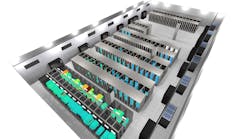The Advantages of Pre-Engineered Data Center Infrastructure
In this edition of Voices of the Industry, Steve Clark, Vice President of Data Center Services at Instor Solutions, explores the advantages of pre-engineered data center infrastructure.
Steve Clark, Vice President of Data Center Services at Instor Solutions
There’s the old saying that you can have things either cheap, fast or good, but you can only pick two. This seems to hold true in the data center world as well, meaning the solutions you choose will either be cheap and fast, cheap and good or fast and good, but not all three at once.
It’s the same in data center deployments — quality, timing and cost are all major factors in the design and configuration of data center physical infrastructure, i.e. hot/cold aisle containment, electrical distribution, structured cabling, and cabinets, etc. Most hyperscale players have this down to a science, but many smaller companies who go it alone discover that they’ve grossly underestimated the amount of time it takes to take a data center build from concept to deployment. To understand the mechanics at work here, let’s take a look at the four steps that go into a typical data center deployment.
Understanding What You Have
Step one includes good, old-fashioned legwork. It’s important to first put critical eyes on what’s in place in your data center to determine which hardware is current and operational and which isn’t. Unfortunately, there’s no shortcut here. The more time you put into this (and the next) step, the better output you’ll have at the end.
Understanding What You Need
Next, you need to look at your existing data center structure and balance it against your current and anticipated future needs. Is your data center packed with a multitude of servers that were required for an initiative five years ago, but now just sit there humming and drawing expensive power? Does the existing design of your structured cabling meet the needs of your future operations? If you build based on past needs, you may end up implementing a solution that doesn’t meet your future business objectives.
Designing What You Need
Often, this is where you’ll introduce third-party designers into the mix to determine the electrical, communications, environmental and security requirements for your new data center. It’s crucial to understand the capacity and function of the facility you’re moving into, be it an expansion, a colocation facility or a new build from scratch. Design solutions that integrate fully with that facility while still providing you the functionality you need for your organization. Here, you’ll need to know which vendors and products will work best for you as well as how the build will be physically put together. Creating a conceptual design and fine tuning the eventual solution can often eat up weeks of time. Many companies are now looking at pre-engineered solutions that have emerged in the market, to cut time and increase quality of the end product. A pre-engineered solution not only brings rapid, modular deployment, but is fully compatible with your facility and your requirements, eliminating weeks — and even months in some cases — from the process.
Building What You Need
This is where things can get extra complicated if you don’t have the prior knowledge and experience of multiple deployments under your belt. A build can be a complex process, involving procuring hardware from multiple suppliers, ensuring the material is delivered in the correct order and that you’re coordinating with multiple contractors to work in the same space at the same time. Invariably, this leads to questions from your own business and internal customers, asking “when will that data center be ready?”
What is a Pre-Engineered Solution?
Pre-engineered solutions are those that come fully packaged. All the pieces and parts arrive at virtually the same time, allowing a single contractor to assemble the solution rather than building it, having to fabricate and modify material to fit the design and the physical space. Also, with pre-engineered solutions, site and contractor coordination is minimized.
A pre-engineered solution not only brings rapid, modular deployment, but is fully compatible with your facility and your requirements, eliminating weeks – and even months in some cases – from the process.
One example of a pre-engineered solution could include containment, electrical and structured cabling, but there are many ways to design such solutions. The point is, this sort of solution might cost a little more up front, but it allows you to deploy quickly and effectively, which has a bottom-line effect, as well. In our experience at Instor Solutions, Inc., we’ve found that pre-engineered data center infrastructure solutions can reduce the time to deployment by up to 30 percent.
In short, getting the design and materials right during the early stages of a project directly impacts your ability to deploy quickly. The initial steps of understanding what you have vs. what you want or need can’t be short-cutted, but if a pre-engineered solution is compatible with your requirements, there is a possibility that it can shave weeks off the time required to design, procure and build your datacenter infrastructure – which means you can be serving your organization or customers significantly faster.
Steve Clark is Vice President of Data Center Services at Instor Solutions.





